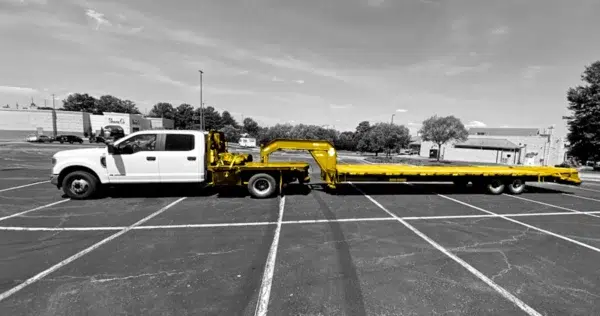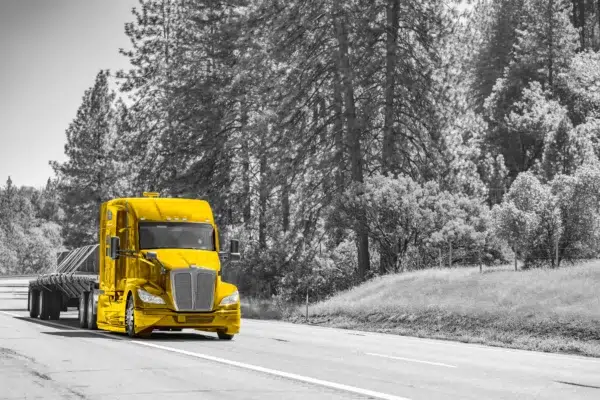
Flatbed Equipment: Types, Specifications, & Uses
July 17, 2024

Flatbed freight transportation is a versatile and efficient method for hauling various types of cargo. Depending on the size, shape, and nature of the load, different types of flatbed trailers are used to meet specific transportation needs.
Understanding these different trailer types is crucial for choosing the right one for your shipment. Here’s a look at the most common types of flatbed freight trailers:
Flatbed Trailers
Flatbeds are the most common and versatile type of flatbed freight trailers. They feature a flat, open deck without sides or a roof, allowing easy loading and unloading from any angle.

Length: Typically, 48’ – 53’
Width: Standard width of 8.5’
Load Capacity: Up to 48,000lbs1
Max Height Capacity: 8’6”
Best For:
- Construction materials
- Machinery and equipment
- Steel and lumber
Step Deck Trailers
Step deck trailers, or drop deck trailers, have a lower deck that drops down after clearing the tractor unit, providing an additional 2 feet of height clearance compared to standard flatbeds.

Upper Deck Height: Typically 60”
Lower Deck Height: Approximately 38”
Width: Standard width of 8.5’
Load Capacity: Up to 48,000lbs*
Max Height Capacity: 10’ – 10’6”
*Legally without permits
Best For:
- Freight that is too tall for standard flatbeds
- Large equipment and machinery
- Agricultural vehicles
Double Drop Trailers
Double drop trailers, also known as lowboy or low-bed trailers, have a lower deck in the middle and higher decks at the front and rear. This design allows them to carry taller loads that exceed the height limits of standard flatbeds.

Length: Typically, 24’ – 29’ for the lower deck
Deck Height: Lower deck can be as low as 18”
Width: Standard width of 8.5’
Load Capacity: Up to 45,000lbs1
Max Height Capacity: 11’6” – 12’*
*Legally without permits
Best For:
- Over-height machinery
- Construction equipment
- Large industrial components
Subscribe!
Subscribe to receive the latest articles, newsletters, whitepapers, and industry news directly to your inbox.
"*" indicates required fields
Lowboy Trailers
Lowboy trailers, similar to double drop trailers, have a low deck height that allows them to carry tall loads that would be over-height on other trailers.

Length: Typically 24’ – 29’
Deck Height: 18” – 24”
Width: Standard width of 8.5’
Load Capacity: Up to 80,000lbs+**
**80,000lbs+ with additional axles
Max Height Capacity: 12’**
**Legally without permits
Best For:
- Over-height and heavy machinery
- Construction equipment
- Industrial loads
Removable Gooseneck Trailers (RGN)
Removable gooseneck trailers (RGN) have a detachable front that allows the trailer to be lowered to the ground, creating a ramp for easy loading of wheeled or tracked vehicles.

Length: Typically 29’ – 65’
Deck Height: As low as 18”
Width: Standard width of 8.5’
Load Capacity: Up to 150,000lbs***
***Depending on the number of axles
Max Height Capacity: 11’6” – 12’**
**Legally without permits
Best For:
- Heavy construction equipment
- Large industrial machinery
- Military vehicles
B-Train Trailers
B-train or B-double, consists of two trailers connected by a fifth-wheel coupling, similar to a tractor-trailer connection, positioned at the rear of the lead trailer. This setup allows the trailers to be more stable and maneuverable than traditional double-trailer configurations.

Length: Typically 28’x28’ or 28’x32’
Deck Height: 40”-60”
Width: Standard width of 8.5’
Load Capacity: Up to 90,000lbs+*
**Weight varies according to the model of the trailer and the combination with the tractor, the time of year, and the state/province.
Max Height Capacity: 8’6”
Best For:
- Heavy and bulk loads
- Construction and industrial equipment
Forestry and agricultural goods
Hot Shot Trailers
Hot shot trailers are smaller, lighter flatbed trailers typically towed by medium-duty trucks. They are ideal for smaller loads that need to be delivered quickly.

Length: Typically 20’ – 40’
Width: Standard width of 8.5’
Load Capacity: Up to 20,000lbs*
*Ideally up to 10,000lbs as equipment capacity significantly decreases over 10,000lbs.
Max Height Capacity: 10’6”
Best For:
- Time-sensitive deliveries
- Smaller loads and partial loads
- Farm equipment
Conestoga Trailers
Conestoga trailers are flatbeds equipped with a rolling tarp system that provides the protection of a dry van with the flexibility of a flatbed.

Length: Typically 48’ – 53’
Width: Standard width of 8.5’
Load Capacity: Up to 45,000lbs
Max Height Capacity: 8’- 8’6”
Best For:
- Weather-sensitive freight
- Loads requiring side or crane loading
- High-value cargo
Auto Haulers
Auto haulers are specialized flatbed trailers designed specifically for transporting vehicles. They come in various configurations, including single-level and multi-level designs.

Length: 53’
Load Capacity: Approximately 6 – 10 cars
Max Weight Capacity: 48,000lbs
Best For:
- New and used car transportation
- Dealership deliveries
- Auction and private car transport
Conclusion
Choosing the right type of flatbed trailer is essential for ensuring the safe, efficient, and compliant transportation of your cargo. Each type of trailer has specific features and benefits tailored to different types of loads and transport requirements. By understanding the capabilities and best uses of flatbeds, double drops, step decks, removable goosenecks, hot shots, lowboys, Conestoga trailers, and auto haulers, you can make informed decisions that meet your shipping needs and ensure the successful delivery of your freight. For quick reference, download our Flatbed Equipment Guide.
Contact Us today to book your next flatbed shipment with TRAFFIX!

